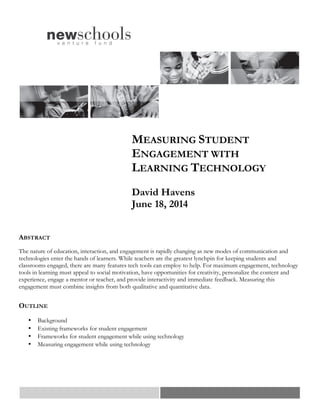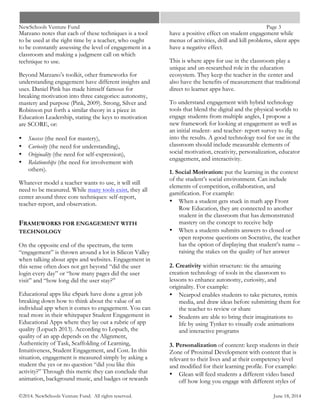This document discusses the evolving nature of student engagement with learning technology, emphasizing the importance of teachers in fostering engagement while integrating technology that appeals to students' social motivation and creativity. It outlines existing frameworks for measuring engagement in educational contexts and proposes a new framework that includes social motivation, personalization, and interactivity as key components for evaluating technology's impact on student engagement. The paper also suggests survey questions for measuring student engagement with educational apps and encourages further exploration of the intersection of technology and engagement.




![NewSchools Venture Fund Page 5
©2014. NewSchools Venture Fund. All rights reserved. June 18, 2014
June 18, 2014, from
http://nsse.iubres.edu/pdf/research_papers/testing_linka
ges.pdf
Christenson, S. (2012). Handbook of research on student
engagement. New York: Springer. (link)
Fijor, M. (2010, April 10). Defining Student
Engagement with Technology - New School
Technology. New School Technology. Retrieved June 18,
2014, from
http://www.newschooltechnology.org/2010/04/defining-
student-engagement-with-technology/
Fredericks, J., & McColsky, W. Measuring student
engagement in upper elementary through high school:
a description of 21 instruments . Regional Education
Laboratory at UNC, REL 2011. Retrieved June 18,
2014, from
http://ies.ed.gov/ncee/edlabs/regions/southeast/pdf/RE
L_2011098.pdf
Harrold, R. (2012). The iPad Effect: Leveraging
Engagement, Collaboration, and Perseverance. The
International Educator. Retrieved from:
http://www.tieonline.com/view_article.cfm?ArticleI
D=100
Lopuch, M. (2013). Student Engagement in
Educational Apps. eSpark Learning. Retrieved May
2014 from http://www.esparklearning.com/student-
engagement-educational-apps-research/
Pink, Daniel. (2009, July). The puzzle of motivation.
[Video file]. Retrieved from
http://www.ted.com/talks/dan_pink_on_motivation
Reading, M. (2014) The Three Foundational
Principles of Student Engagement and Student
Motivation. Retrieved June 18, 2014, from
http://teacherstraining.com.au/the-three-foundational-
principles-of-student-engagement-and-student-motivation-
pt1/
Resnick, M.D., Harris, K.M., & Shew, M. (1997).
Protecting adolescents from harm: Findings from the
National Longitudinal Study on Adolescent Health.
Journal of the American Medical Association, 278,
823-832.
Sandholtz, J.H., Ringstaff, C. Student Engagement
(1991): Views from Technology Rich Classrooms.
Apple Computer, Inc. Retrieved June 18, 2014, from
http://www.apple.com/euro/pdfs/acotlibrary/rpt21.pdf
Acknowledgements: thanks to Jennifer Wolf, Karin
Forssell, and Jennifer Carolan for feedback and
guidance along the way.](https://image.slidesharecdn.com/measuringstudentengagementwithlearningtechnology-140620145743-phpapp02/85/Measuring-student-engagement-with-learning-technology-5-320.jpg)